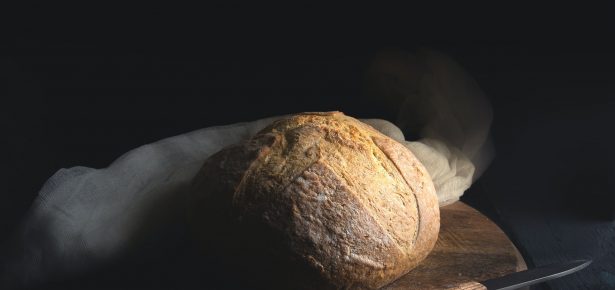
I too have measured out my life with coffee spoons in the endless days of the lockdown. Instant coffee, to be precise, as I follow the global Dalgona coffee phenomenon that appears daily in my ‘news’ feed. Frothy and photogenic, this take on a South Korean confection has been an easy 4 pm staple in the last month. Perhaps it’s been longer than a month, but as a coworker on Zoom bemoaned, time has no real meaning in quarantine. She then excused herself briefly to check on a rising sourdough in her kitchen. She isn’t the only one proofing yeast and kneading dough in an apocalyptic frenzy. The Washington Post reports that we might well be running out of flour and yeast in grocery store aisles, as newly incarnated bakers seek refuge in shared rituals on Instagram.
The specter of empty aisles in the supermarket seems to be at odds with these images of homemade plenitude. For those of us who have lived through eras of food shortages and rationing in the global South, the lines of masked shoppers obediently maintaining social distancing two blocks around a Trader Joe’s are as disconcerting as they are orderly. “I’m not obsessed with food, nor am I a hoarder. The coronavirus has just triggered…a ‘cultural memory,’” Mirta Ojito writes in The New York Times. It is a memory of Cuba in the ’70s, when she remembers standing in endless lines for potatoes, dreaming of apples, and watching ice cream trucks disappear from the landscape of her childhood. “I Can’t Bring Myself to Stand in Line for Food Again,” she confesses, as the shortages have come back “full circle,” forty years after her family left Cuba.
In Indian immigrant food groups that I joined on Facebook in happier times, I now see the same anxieties, giving rise to a new exchange of experiential knowledge. What do you use in lieu of gram flour when it runs out, how do you use up vast quantities of fenugreek before it spoils, where do you store ground cilantro when fresh herbs are no longer accessible? A strange mix of the practical and heuristic with the impractical and indulgent, these posts are reminiscent of M.F.K. Fisher’s wartime advice books. Like How to Cook a Wolf, they have little in the way of cost saving tips for hard times, but reveal much about the ethos of performed prudence and austerity in a global crisis.
Perhaps they reveal the collective inheritance of a generation that is old enough to remember the ration cards that brought limited quantities of rice, sugar, and grains to poor and middle-class Indian families as late as the ’80s, even if they are too young to have lived through the post-Second World War famines that resulted in its establishment. An analog might be found in the resurgence of Victory Gardens across America, with novice gardeners attempting to gain some sense of control over food supply chains during the Corona lockdowns, much like their grandparents did, albeit with greater urgency, in post-War America.
Certainly, for large parts of the globe, hunger will kill before Corona. In a sobering piece, The New York Times documents the desperation of the hungry: stampedes in the slums of Kenya for flour and cooking oil giveaways; migrant workers lining up for bread and vegetables in India; households hanging red clothing on their balconies in Colombia to signal their need for food. The article predicts that the number of people facing hunger across the world could double to 265 million by year’s end.
Indeed, the end of the year could leave us with radically altered foodscapes even in the most affluent parts of the world. The tiny immigrant eateries of the Mission District in San Francisco have all but disappeared. The last time my family stopped by for Indian takeout, the owner teared up in a farewell of sorts, unsure if he could afford to pay his staff much longer. It is hard to imagine the vibrant commensal rituals of dining together, in the cozy proximity necessitated by San Francisco’s real estate, returning to any version of what we knew and loved.
Our work in food studies, whether as historians, anthropologists, or literary critics, will no doubt, take on more urgency in the wake of this crisis. The food ephemera of the digital world, the food rituals of a quarantined world, the food stories of the hungry, the sick, and the grieving, will have to be chronicled and archived in ways that fully and forcefully convey the ennui, the dread, the loneliness, and the anxiety of a time when we could no longer break bread together.
Latest Comments
Have your say!